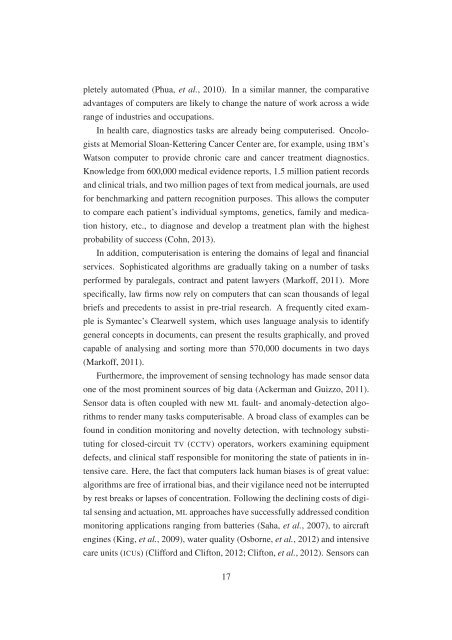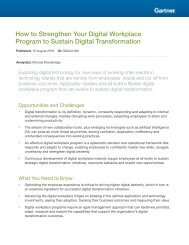The_Future_of_Employment
You also want an ePaper? Increase the reach of your titles
YUMPU automatically turns print PDFs into web optimized ePapers that Google loves.
pletely automated (Phua, et al., 2010). In a similar manner, the comparative<br />
advantages <strong>of</strong> computers are likely to change the nature <strong>of</strong> work across a wide<br />
range <strong>of</strong> industries and occupations.<br />
In health care, diagnostics tasks are already being computerised. Oncologists<br />
at Memorial Sloan-Kettering Cancer Center are, for example, using IBM’s<br />
Watson computer to provide chronic care and cancer treatment diagnostics.<br />
Knowledge from 600,000 medical evidence reports, 1.5 million patient records<br />
and clinical trials, and two million pages <strong>of</strong> text from medical journals, are used<br />
for benchmarking and pattern recognition purposes. This allows the computer<br />
to compare each patient’s individual symptoms, genetics, family and medication<br />
history, etc., to diagnose and develop a treatment plan with the highest<br />
probability <strong>of</strong> success (Cohn, 2013).<br />
In addition, computerisation is entering the domains <strong>of</strong> legal and financial<br />
services. Sophisticated algorithms are gradually taking on a number <strong>of</strong> tasks<br />
performed by paralegals, contract and patent lawyers (Mark<strong>of</strong>f, 2011). More<br />
specifically, law firms now rely on computers that can scan thousands <strong>of</strong> legal<br />
briefs and precedents to assist in pre-trial research. A frequently cited example<br />
is Symantec’s Clearwell system, which uses language analysis to identify<br />
general concepts in documents, can present the results graphically, and proved<br />
capable <strong>of</strong> analysing and sorting more than 570,000 documents in two days<br />
(Mark<strong>of</strong>f, 2011).<br />
Furthermore, the improvement <strong>of</strong> sensing technology has made sensor data<br />
one <strong>of</strong> the most prominent sources <strong>of</strong> big data (Ackerman and Guizzo, 2011).<br />
Sensor data is <strong>of</strong>ten coupled with new ML fault- and anomaly-detection algorithms<br />
to render many tasks computerisable. A broad class <strong>of</strong> examples can be<br />
found in condition monitoring and novelty detection, with technology substituting<br />
for closed-circuit TV (CCTV) operators, workers examining equipment<br />
defects, and clinical staff responsible for monitoring the state <strong>of</strong> patients in intensive<br />
care. Here, the fact that computers lack human biases is <strong>of</strong> great value:<br />
algorithms are free <strong>of</strong> irrational bias, and their vigilance need not be interrupted<br />
by rest breaks or lapses <strong>of</strong> concentration. Following the declining costs <strong>of</strong> digital<br />
sensing and actuation, ML approaches have successfully addressed condition<br />
monitoring applications ranging from batteries (Saha, et al., 2007), to aircraft<br />
engines (King, et al., 2009), water quality (Osborne, et al., 2012) and intensive<br />
care units (ICUs) (Clifford and Clifton, 2012; Clifton, et al., 2012). Sensors can<br />
17





